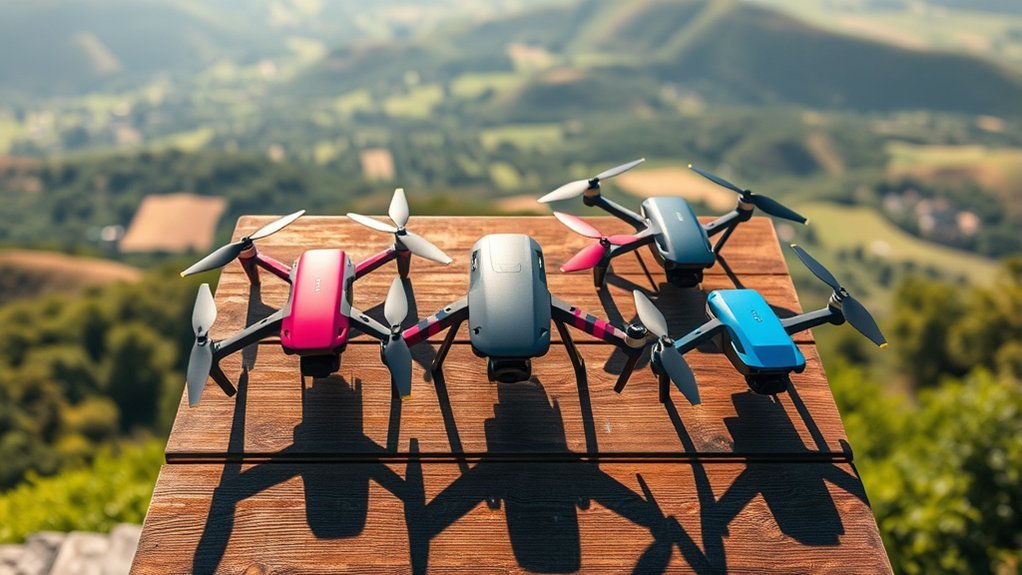You might not realize that the right drone can considerably enhance your mapping accuracy and efficiency. With advancements in technology, several options stand out for their precision and performance. Whether you’re a professional or a hobbyist, choosing the right drone can make all the difference. Let’s explore the top five picks that could elevate your mapping projects to the next level.
Drone with Camera for Adults, 2K HD FPV Drones
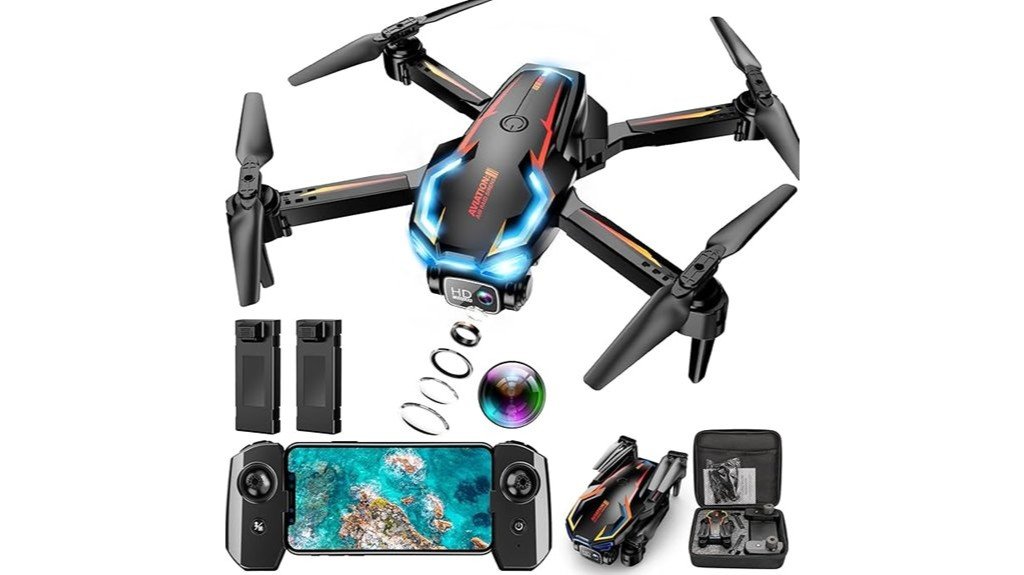
If you’re an adult looking for a reliable drone for mapping, the Loiley Drone with its 2K HD camera is an excellent choice. This compact 2K HD FPV drone measures just 9L x 7W x 3H inches when expanded, and it’s lightweight at under 250g—no FAA registration necessary. With two rechargeable batteries offering a total flight time of approximately 26 minutes, you can capture stunning aerial images. Its remote-adjustable camera angle guarantees you get the perfect shot, while gravity sensing provides intuitive control. Plus, safety features like propeller guards make it a smart option for your mapping needs.
Best For: Adults seeking a compact and user-friendly drone for mapping and photography.
Pros:
- High-Quality Imaging: 2K Ultra HD camera with a remote-adjustable angle for capturing stunning aerial shots.
- User-Friendly Features: One-key take off/landing, speed adjustment, and gravity sensing for easy control.
- Safety Measures: Includes propeller guards and overvoltage protection in batteries for safer operation.
Cons:
- Limited Flight Time: Total flight time of approximately 26 minutes may require extra batteries for extended use.
- Size Limitations: While compact, the size may not suit those looking for larger drones with more advanced features.
- Availability: First available on May 15, 2025, which may delay purchase for interested customers.
GPS Drone with Camera and 4.5 LCD Screen
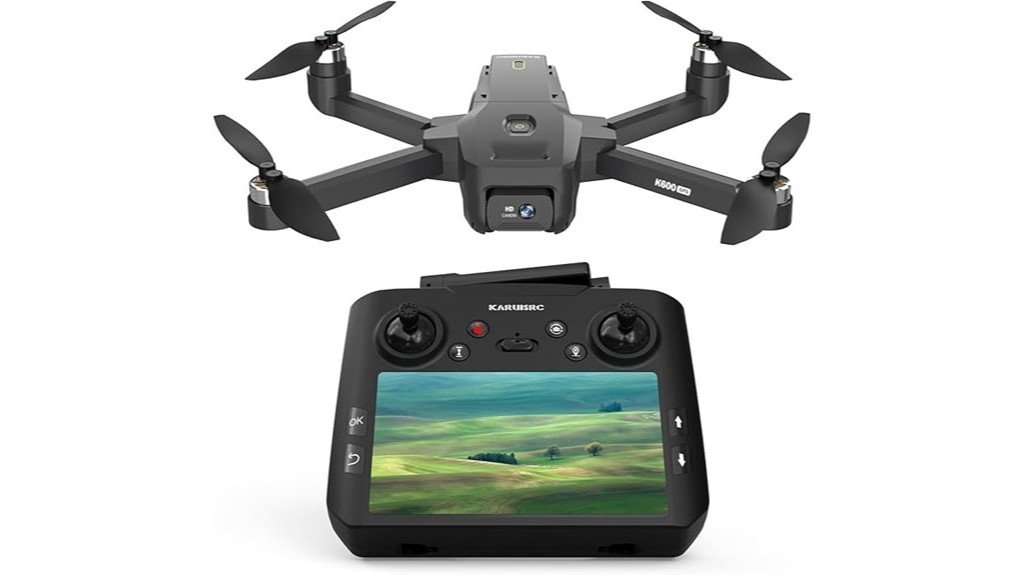
The GPS Drone with Camera and 4.5 LCD Screen is perfect for mapping enthusiasts who value real-time footage and user-friendly operation. Weighing just 205.8 grams, this compact drone boasts a high-definition camera that captures vibrant landscapes with impressive color accuracy. The 4.5-inch HD screen allows you to preview and transmit footage seamlessly. With a control range of 400 meters and 250 meters of mapping capability, you can explore confidently. Plus, the precision GPS guarantees stable positioning and automatic return. Suitable for all skill levels, it’s an excellent choice for anyone looking to elevate their mapping experience.
Best For: Mapping enthusiasts and beginners seeking an easy-to-use drone with real-time footage capabilities.
Pros:
- High-definition camera captures vibrant landscapes with professional color accuracy.
- User-friendly operation suitable for all skill levels, making it accessible for beginners.
- Compact design with a lightweight build, making it easy to transport.
Cons:
- Limited control range of 400 meters may restrict exploration in larger areas.
- Battery life may require frequent recharges for extended use.
- The 4.5-inch LCD screen may be small for some users when previewing footage.
2K HD FPV Drone with Camera for Adults
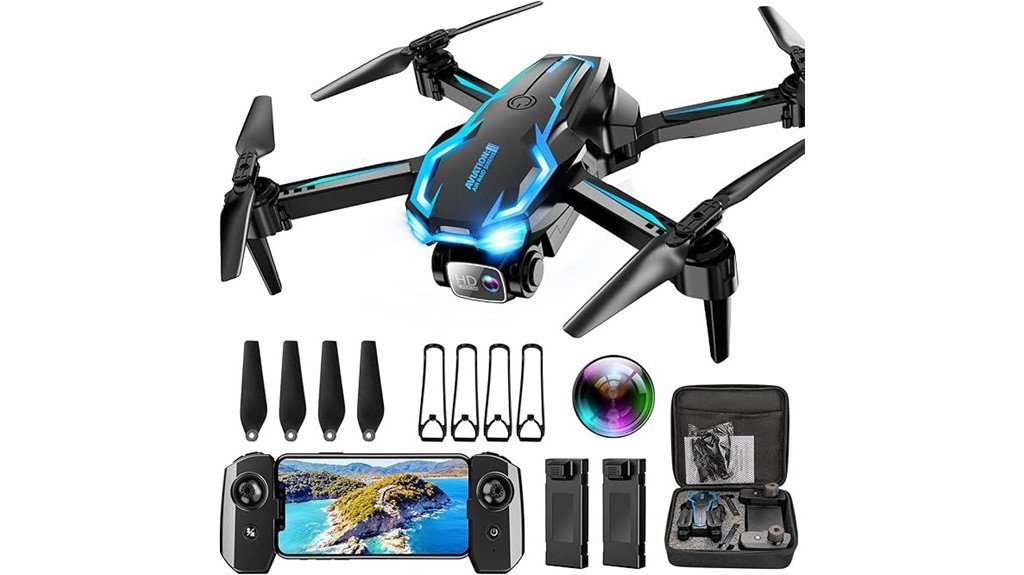
For adults seeking an easy-to-use drone that captures stunning visuals, the 2K HD FPV Drone (X69) by Loiley stands out with its 2K Ultra HD camera and real-time FPV transmission. With intuitive controls like one-key takeoff and altitude hold, you’ll find it perfect for both beginners and seasoned flyers. Weighing under 250g, it’s ultra-portable, making it a great companion for outdoor adventures. Plus, with two rechargeable batteries offering up to 20 minutes of flight time, you can enjoy extended sessions. The robust design guarantees durability, while the included travel bag adds convenience for on-the-go enthusiasts.
Best For: Adults and beginners looking for an easy-to-use drone that captures high-quality visuals for recreational flying.
Pros:
- User-Friendly: Intuitive controls and quick setup make it accessible for beginners.
- Portable Design: Weighs under 250g and fits easily in a pocket or backpack, perfect for travel.
- Durable Build: Robust design withstands minor crashes, ensuring longevity.
Cons:
- Video Feed Delay: Slight delay in the video feed may affect real-time viewing experience.
- Limited Flight Time: Total runtime of approximately 20 minutes per battery may not satisfy extended flying sessions.
- Camera Performance: While clear for casual use, may not meet the expectations of professional photographers.
N11 Pro 4K UHD Camera Drone for Adults
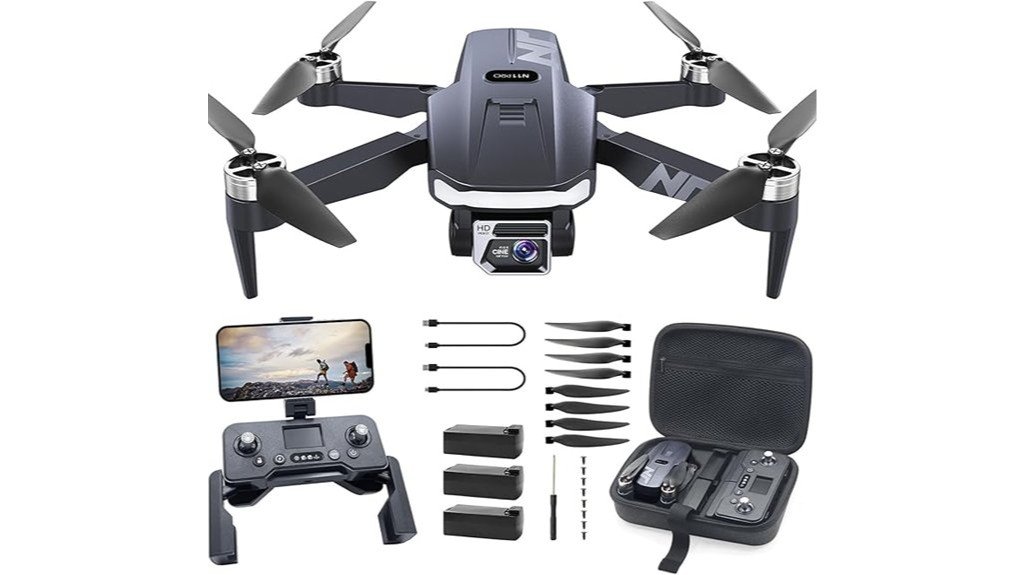
Designed with new flyers in mind, the N11 Pro 4K UHD Camera Drone stands out as an excellent choice for adults looking to explore mapping and aerial photography. Weighing under 0.55 lbs, it’s FAA-free, making it easy to fly without hassle. With a flight time of up to 90 minutes and a control range of 3,328 feet, you’ll capture stunning 4K photos and videos effortlessly. Its GPS and optical flow features guarantee precise navigation, while the auto return function keeps your drone safe. With a 4.9-star rating, it’s user-friendly, stable, and perfect for both indoor and outdoor adventures.
Best For: Adults and new flyers looking for an easy-to-use drone for mapping and aerial photography.
Pros:
- User-friendly design makes it ideal for beginners with intuitive controls.
- Impressive flight time of up to 90 minutes allows for extended aerial exploration.
- High-quality 4K camera captures stunning photos and videos for memorable experiences.
Cons:
- Limited control range of 3,328 feet may not satisfy advanced users seeking longer distances.
- Plastic/metal construction may not be as durable as higher-end models.
- 30-day money-back guarantee may not be sufficient for users wanting longer warranty options.
Autel Robotics EVO II PRO RTK V3 Drone
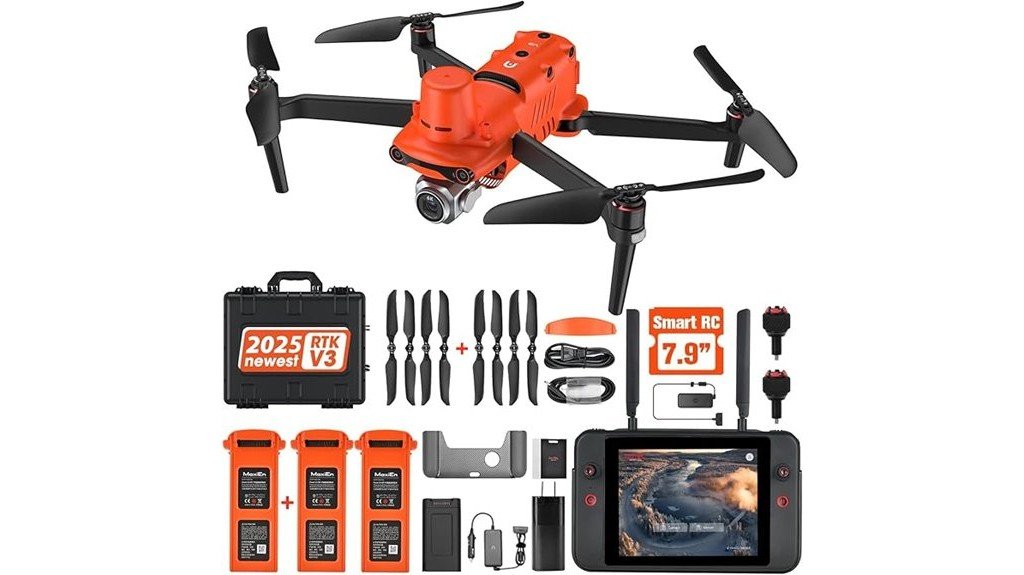
Offering remarkable real-time centimeter-level positioning, the Autel Robotics EVO II PRO RTK V3 Drone stands out as an ideal choice for professionals in mapping and surveying. With a 6K HDR camera and a battery life of 38 minutes, you’ll capture stunning visuals while covering large areas. Its RTK module guarantees accuracy of 1 cm horizontally and 1.5 cm vertically, eliminating the need for ground control points. You can automate mission execution with customizable flight routes, making data acquisition seamless. Plus, it’s versatile for various applications like urban planning and search and rescue, all while being FAA compliant.
Best For: Professionals in mapping, surveying, and various industrial applications who require high precision and reliable data acquisition.
Pros:
- High Accuracy: Provides real-time centimeter-level positioning without the need for ground control points.
- Long Battery Life: Offers up to 38 minutes of flight time, allowing for extensive coverage in a single mission.
- Versatile Applications: Suitable for a wide range of uses, including urban planning, search and rescue, and environmental protection.
Cons:
- Cost: May be more expensive compared to non-RTK drones, limiting accessibility for smaller businesses or hobbyists.
- Complexity: Requires expertise to fully utilize advanced features and ensure optimal performance in various conditions.
- Regulatory Compliance: Must adhere to FAA regulations, which may restrict usage in certain areas or require additional certifications.
Factors to Consider When Choosing Drones for Mapping
When choosing a drone for mapping, you need to take into account several key factors that can impact your results. Camera resolution, flight time, GPS accuracy, payload capacity, and user-friendly controls all play essential roles in your mapping efficiency. Keep these points in mind to guarantee you select a drone that meets your specific needs.
Camera Resolution Importance
While selecting a drone for mapping, you can’t overlook the importance of camera resolution. A high-resolution camera, like 4K or 2K, captures images and videos that provide the detailed visuals necessary for precise mapping and analysis. With a higher resolution, you’ll see clearer topographical features, essential for surveying, land use planning, and environmental monitoring. Drones equipped with advanced camera capabilities enhance color accuracy and clarity, improving the quality of your data. Plus, capturing high-resolution images can cut down on the need for ground control points, making your mapping process more efficient and cost-effective. Ultimately, enhanced camera resolution leads to better post-processing results, allowing for more accurate orthomosaics and 3D models in your mapping projects.
Flight Time Considerations
Flight time is a critical factor to contemplate if you want to maximize your mapping efficiency. Longer flight times let you cover larger areas without constantly swapping out batteries. Some drones can fly for up to 90 minutes, making them ideal for extensive missions. It’s wise to check the average flight time of the models you’re considering, as many consumer drones typically last only 15 to 30 minutes. Keep in mind that added weight from equipment or sensors can drain the battery faster. Drones featuring automatic return-to-home on low battery are also a smart choice, ensuring your drone returns safely before running out of power and preserving your valuable mapping data.
GPS Accuracy and Stability
Maximizing mapping efficiency isn’t just about flight time; GPS accuracy and stability play a significant role in guaranteeing precise data collection. You’ll want a drone with advanced GPS systems that achieve centimeter-level accuracy through real-time kinematic (RTK) positioning. Stability during flight is essential—vibrations or sudden movements can lead to positioning errors. Drones equipped with dual positioning systems, like GPS and optical flow, enhance both accuracy and stability, serving well in various environments. Consider the control range of the drone, as a longer range allows for surveying larger areas without losing GPS signal. Finally, make sure your drone can withstand varying weather conditions, as wind resistance is critical for maintaining GPS accuracy during outdoor mapping projects.
Payload Capacity Needs
When selecting a drone for mapping, understanding payload capacity is essential since it dictates the weight of the camera and other equipment you can carry. Drones with a higher payload capacity, typically over 5 kg, allow for professional-grade cameras and sensors that capture higher resolution images, enhancing your mapping quality. However, you should also consider the drone’s power-to-weight ratio; heavier payloads can reduce flight time and stability, impacting mapping effectiveness. Ideally, your drone’s payload capacity should exceed the combined weight of your camera, gimbal, and any additional sensors by at least 20%. Additionally, be aware of regulatory restrictions based on the drone’s loaded weight to guarantee compliance with aviation laws and safe operation.
User-Friendly Controls
Selecting a drone with user-friendly controls can greatly enhance your mapping experience. Look for features like one-key takeoff and landing, which simplify operation, especially for beginners. Intuitive flight controls, such as headless mode and gravity sensing, make navigation easy, accommodating various skill levels. Consider drones with speed adjustment settings so you can choose a pace that matches your confidence, ensuring a comfortable flying experience. Many models incorporate optical flow positioning technology, stabilizing flight and allowing you to focus on capturing high-quality mapping data. Additionally, ergonomic remote control designs improve handling, enabling precise control during your mapping missions. Prioritizing these features will help you achieve better results with less frustration.
